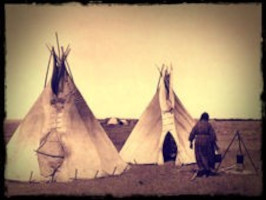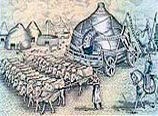
History of Tepee
History of Tepee
Ti pi is a term of Lakota (Sioux) origin that means “to live” (in English tepee, teepee). The tipi is the original nomadic dwelling of the Great Prairie tribes of North America. Perhaps it is the most useful, comfortable and beautiful of all portable homes that have been created so far…
No one knows for sure which Native American tribe developed the tepee for the first time, since it has been (and still is) used by many of them: Lakota (Sioux), Apsalooke, Kiowa, Cree, Objiway and so on, which count with different names and legends about its creation. Thus, for example, the Apsalooke (Crow) natives call it Ashé and the Black Feet (Blackfoot) call it Niitoy-Yiss. According to the Cree tribe, it was created by some children while playing with the cotton leaves and some twigs. What is easier to determine, is to which tribe a tepee or a camp belonged, due to its design, which presented slight variations from one group to another. While aspects such as the shape of the cone, the wings, the structure of sticks, etc. determined the differences, basically the styles of tepees can be grouped into two broad categories according to their architecture: -Those who they are built on a tripod (eg Lakota, Soshoni, Cheyenne, Assiniboine) -Those that are built on a quadripod (eg Blackfoot, Apsalooke, Comanche). The Lakota have been experts in making their shelters practical and very comfortable!
The first tepees were made in leather and sewn with tendons. The skins were mostly buffalo, tanned in the spring but they could also be made of deer, elk or antelope skin.The sticks were made of pine, abundant in the hills and valleys of the Rocky Mountains, and cut in the summer On average, formerly, tepees were 5 or 5.5 meters in diameter and were designed for a family. In some cases, tepees of 3 meters in diameter were also made for children to play and larger tepees, 7 or 7.5 meters in diameter, for Council meetings. When it was hot the wings for smoke were open and the Bottom of the tepee cover was rolled up, allowing air to circulate freely. In winter, an inner skirt was added thus providing insulation. The fire that burned in the center of the store was responsible for maintaining the heat in the tepee. Easy to mount, an average tepee could be assembled or disassembled in less than an hour by the women of the tribe, the true owners of the tepee… The man, warrior and hunter, was responsible for decorating it with paintings, capturing historical or mystical designs obtained through his dreams and visions, and that granted protection to the inhabitants of the house. The traditional decoration of a tepee included a bed of leather, chairs-backrest of willow rod bed (backrest), a kitchen tripod, supply of firewood, bags containing food, medicine and other necessities… In the insulated skirt of the tepee, sacred objects, weapons, shields and others were hung elements.
When a woman decided to build a tepee, she invited all her friends to eat and after the banquet they helped with the operation of cutting and sewing fur. Upon reaching the sewing of the wings for the smoke, the women took care that this important work was entrusted to a person who was reputed to be happy, since it was believed that if the work was carried out by a person of bad character, Wings would not work well and the tepee would always be filled with smoke. During the summer, the tribe groups gathered in a single circle, to celebrate the Dance of the Sun. The tepees mounted in rows of three or four, forming a large circle, which represented the Circle of Life. In the center there were only the tepees of the Council, which contained the sacred objects of the tribe. The 2 great innovations that the tepee lived from its origin to the beginning of the 20th century were:
1) The arrival of the horse to America, which facilitated the hunting, and allowed to transport sticks and larger skins through the “travois” system and consequently create larger tepees.
2) At the beginning of the 19th century the use of skins for the cover was replaced by cotton canvas, which facilitated transport, assembly and construction of the tepee and allowed more light to enter inside.



















